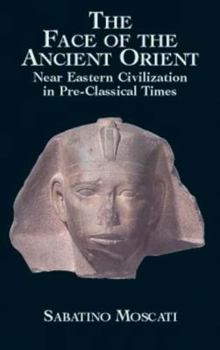The Face of the Ancient Orient: 16 Art Stickers
Select Format
Select Condition 
Book Overview
"A lucid, intelligent, and lively summation ... an appetizing and stimulating introduction to the study of man's early civilizations." -- Science
This fascinating, lively study -- praised by the American Historical Review as "a valuable introduction, perhaps the best available in English, to the ancient Near Eastern civilizations" -- is essential reading for history students and for anyone interested in the development of Western...
Format:Paperback
Language:English
ISBN:0486419525
ISBN13:9780486419527
Release Date:August 2001
Publisher:Dover Publications
Length:384 Pages
Weight:0.85 lbs.
Dimensions:0.7" x 5.7" x 8.5"
Customer Reviews
1 rating
Two & a Half Millennia of Civilisation
Published by Thriftbooks.com User , 19 years ago
Anyone reading this book must bear in mind that it is a reprint of the English edition published in 1960 and therefore does not reflect current scholarship. However, it is a useful introduction to the civilisations of the ancient Near East, starting with the Sumarians, followed by the Akkadians (i.e. the Babylonians and Assyrians), Egyptians, Hittites, Hurrians, various Semitic tribes, and finally the Persians, each of whom are examined in turn. The focus is not on political history, but on culture as reflected in religion, literature, architecture, and art, with prominence given to the first two. It is not a systematic exposition, but a brief outline with references to the scholarly works that were available at the time of original publication. An important point that made is that current knowledge of these ancient peoples is limited to the documents and archaeological remains which have been preserved and discovered, often by chance. Typical of the format is the chapter on the Sumarians, who, in their city states of Kish, Lagash, Umma, and Ur amongst others, are the first people in this region for which there is historical as well as archaeological evidence. Moscali discusses and gives extracts from the earliest royal inscriptions, although perhaps some of his conclusions stretch the material too far. Attention is then paid to Sumarian concept of the gods and their worship. The literature of the Sumarians is represented by a vast quantity of cuneiform inscribed clay tablets. These texts, of which several examples are given, comprise myths of the gods and heroic legends, including the epic poem of Gilgamesh; hymns, prayers, incantations, and fables; scientific, legal and commercial documents. Finally the characteristic architecture of temples and palaces and art, mainly statuary and bas-reliefs, are outlined and illustrated by a few relevant, although poorly reproduced plates. The reader is given a frame of reference for these ancient civilisations which places them in context vis-à-vis each other without being dragged into the minutiae of political events or scholarly debates. The picture that emerges is that of two great centres of civilisation which arise in the river valleys of Mesopotamia and the Nile who interact with their neighbours from the mountains and desert in politics, religion, and art until the whole of the Near East is united under the control of the Persians. The author is prone to making grand generalisations, especially in the concluding chapter, but these are easily recognisable and indeed forgivable since he seeks to summarize more than two and a half thousand years of civilisation in a slim volume.






